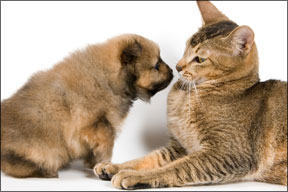Some folks are “dog people,” while others have an affinity for cats. But what do you do when enthusiasts of both persuasions share the same home? Despite the conventional wisdom that dogs and cats cant peacefully coexist, both species can inhabit the same space without the fur flying. However, introducing a cat into 288 a dog-centric home requires planning, patience and a commitment to the process. How long it takes to successfully integrate a new cat with a dog depends on the situation, says Katherine Houpt, VMD, PhD, board-certified by the American College of Veterinary Behaviorists and emeritus professor of animal behavior in Cornell Universitys College of Veterinary Medicine. “It can take anywhere from days to weeks, and it varies a lot with the dogs reaction,” she says. “I think its important to increase exposure gradually when doing an introduction so you can monitor both animals reactions. That usually happens over a number of days.” Throwing the two animals together and letting the dust settle is almost universally a bad idea. “The worst danger is the death of the new animal. Secondly, theres a danger of injury to the dog; thirdly, you can cause a fear reaction in either animal that may be difficult to overcome,” says Dr. Houpt. The best way to facilitate an introduction and eventual integration is to follow a carefully orchestrated strategy – one that begins before the cat even sets foot into the house. Screen for Predatory Behavior. If your dog has a history of flying after squirrels or other small animals, its safe to say that he has a fairly well-developed prey drive or has simply learned to enjoy the thrill of the chase. Either way, this poses a major challenge to your success in adding a cat to the household equation. When threatened by a larger predator, most cats react by fleeing. Unfortunately, this plays right into a primary canine instinct – to chase smaller creatures, either for amusement or to hunt. Thats not to say that this drive cant be overcome; rather, you must take extra precautions when the two animals first meet and expect to spend a significant amount of time using positive reinforcement techniques to keep the dogs chasing behaviors in check. If you dont know how your dog will act around a small animal, test it out, says Dr. Houpt. “You can simply take it to visit other animals – on leash – to see if your dog is really predatory.” If your dog has caught and killed cats or other animals in the past, youre beyond red flags: Do not try to convince yourself that you can successfully eradicate or contain this type of behavior. “Ive seen cases where dogs have broken into homes through screened porches to kill cats,” cautions Dr. Houpt. In this case, its better to resign yourself to life without cats or other small animals in the household. Make Positive Associations. The Humane Society of the United States (HSUS) recommends a very slow introduction that uses food and smell to get the animals used to each other. First, they suggest, confine the cat in a room with her litter box, food, water and a bed – but with no possible contact with the dog. Feed your cat on one side of the door and your dog on the other. Doing this will create pleasant associations with the presence of the other animal. (Depending on how eager your dog is to meet the newcomer, you might consider keeping her on a leash or crated for this process.) In addition, you can rub the cat with a cloth and leave it for the dog to examine, and do the same for the cat. When your cat is comfortable in her new room and is using the litter box, says the HSUS, switch things up by confining your dog in the room and allowing the cat to roam the house. This gives the dog the opportunity to explore the cats domain and scent in more detail, while the cat can begin to get comfortable in her new surroundings. Exercise Restraint. When you feel the dog and cat are ready to come face-to-face, says Dr. Houpt, start with the cat in a carrier and the dog leashed or restrained so she cant charge the container. Assess your dogs reaction. If she seems mildly curious or friendly and the cat doesnt seem panicked, you can allow the dog to investigate the carrier and the cat. You can reinforce the experience for both animals by feeding them treats (you may need to recruit a partner so you can each focus on one animal). Keep the meeting short and repeat this step several times over several days until both animals are tolerating each others presence and seem relaxed. Next, set up a barrier the animals can see through, such as a baby gate, and let the cat free on one side with the dog on the other. “If the dog is going up to the barrier and doesnt seem too interested, thats a good sign,” says Dr. Houpt. “Danger signs are intense interest, staring and attempts to get at the cat through the barrier. If you have a dog that just lies staring at the cat, thats probably not a friendly interest. Thats a predatory behavior and that dog may ultimately try to kill the cat.” Again, reinforce calm behavior for both animals with treats. Practice putting your dog in a down/stay while the cat roams around and reward him for staying in this position quietly. Preparing for Free Interaction. When you feel that both animals are sufficiently used to each other, its time to try a face-to-face meeting. Keep your dog on a leash, put her into a down/stay, and allow the cat to approach on her own terms. This is a great time to give your dog high-value treats for staying in position. If she leaves her down/stay, lure her back into position or, if she shows signs of getting too excited, calmly remove her from the room. If the cat runs away or shows aggressive behavior toward the dog, return to the previous step. If your dog shows signs of chasing, dont punish her; simply encourage her back into a down/stay, redirect her attention, calmly leave the room with her, or remove the cat from the situation. If you respond with a correction or a punishment to the dogs actions toward the cat, she will begin to associate the cat – rather than her own reactions to the cat – with the negative consequence. This can create an association that will be very difficult to remove and can lead to increased aggression in the future. Its also important that you freely reward “appropriate” behaviors from your dog, including sitting, lying down or just plain ignoring the cat. Make no mistake: This is the hard part. “We have had people whove done months and months of obedience work with the dog in the presence of the cat,” says Dr. Houpt. “Every time the dog made a move toward the cat, the owner used a Gentle Leader head harness to have him sit. If the owner is committed, that can work, but it takes a long time.”



